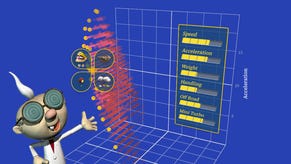GDC: Xbox 2's High Def future trumpeted
XNA chief J Allard reveals several key elements of Microsoft's Xbox 2 plans.
Video footage of the keynote and screenshots of Xbox 2's "Guide" are now available elsewhere on the site.
Microsoft executive J Allard today ushered in a new era of 'High Def' (HD) gaming, and used his keynote address at the Game Developers Conference in San Francisco to assert that Microsoft's next generation console was in a postion to be at the very centre of driving this new "HD Era".
Allard refused to reveal any direct information relating to Xbox 2, insisting that the big unveiling would be saved for E3. The XNA boss instead focused on the bigger picture of the important role that high definition TV displays would play and how the "Remix Generation" wanted to personalise every aspect of their entertainment experiences. He noted that the games industry was in the perfect position to take advantage of the apparent consumer thirst for customisation in every area of their lives.
"In the HD Era the platform is bigger than the processor," Allard said. "New technology and emerging consumer forces will come together to enable the rock stars of game development to shake up the old establishment and redefine entertainment as we know it."
Embarrassingly for Microsoft, the keynote announcement was leaked several hours before his address by Dutch PR firm Citigate today and detailed all the major points of Allard's keynote. In the address, Allard stated that Xbox 2 is designed to make life easier for developers - supporting familiar tech "such as DirectX, PIX, XACT and... XNA Studio", and wresting control of key Xbox functions like voice chat, Friends lists and custom soundtracks out of their hands in order to ease the production process and let them "focus on creating games, not developing for technical certification requirements (TCRs)."
In other words, things like voice communication, in-game Friends list management, custom soundtracks and the like will become standard features of the console - controlled, we're told, "at chip level" - and apply to every game regardless of whether or not the developer would have included them otherwise. During the keynote Allard used the soon-to-be released Forza Motorsport to give a fair indication of what to expect in the next gen, with new features such as in-game alerts providing instant feedback to new challenges from friends, and asserted that the whole user interface would be standardised to make it an easier, more intuitive experience for end users.
Meanwhile, with yet more reference to the "HD Era" the official release from Microsoft stated that Xbox 2 will represent "a significant leap to high-definition graphics" - reflecting reports that the console will shoot for HDTV/progressive scan support as standard - as well as "multichannel, positional audio fidelity so clear and precise that players will be able to hear the faintest enemy footsteps sneaking up behind them" and "an abundance of on-demand content for game consoles".
Allard also promised Xbox 2 would deliver "more than a teraflop of targeted computing performance" thanks to "a multicore processor architecture co-developed with IBM" providing "developer headroom and flexibility", and mentions the custom graphics chip from ATI which Microsoft has itself already announced.
That ties in with a second report that emerged earlier this week claiming to confirm that Xbox 2 will feature optional hard disks, dual-layer DVD-9 discs as standard, memory cards ranging from 64MB to 1GB, and 256MB of system RAM. Microsoft said it would not comment on "rumours and speculation" when confronted with those details.
Xbox 2 will also feature a central "Marketplace" resource where user and developer-made bonus game content is sold for sums as little as 99 cents, doing away with the clunky Downloadable Content facility currently used by Xbox Live titles, as well as "Gamer Cards" - essentially expanded Xbox Live profiles storing game preferences and other personal information input by the user to help people track down like-minded opponents, today's release declares.
Meanwhile, the continual reference to the "HD Era" by Allard throughout his keynote was expanded upon as a clear move out of the "3D era" into a whole new one. He also talked of the "guide", described as an "entertainment gateway that instantly connects players to their games, their friends and their digital media".
Allard's unveiling elements of Xbox 2 today somewhat mirror the way Microsoft announced the original Xbox at CES in 2001 rather than the traditional platform of the Electronic Entertainment Expo. However, it's now 100 per cent clear that E3 will be the platform for the console's full unveiling, ending months of frenzied rumour and guesswork.
The full text of the official press release issued follows:
SAN FRANCISCO — March 9, 2005 — Today at the annual Game Developers Conference (GDC), Microsoft Corp. announced the first details of its next-generation Xbox® video game system platform, highlighting how hardware, software and services are being fused to power enhanced game and entertainment experiences.
Microsoft Corporate Vice President and Chief XNA™ Architect J Allard further outlined the company’s vision for the future of entertainment, citing the emergence of an “HD Era” in video games that is fueled by consumer demand for experiences that are always connected, always personalized and always in high-definition.
“In the HD Era the platform is bigger than the processor,” Allard said. “New technology and emerging consumer forces will come together to enable the rock stars of game development to shake up the old establishment and redefine entertainment as we know it.”
Building on 10 years of innovation with the DirectX® API, the Microsoft® Windows® and Xbox platforms will enable ground-breaking game experiences in the HD Era. Illustrating what that means for gamers, Allard shared the first details about the next-generation Xbox guide. Persistent across all games and media experiences, the guide is an entertainment gateway that instantly connects players to their games, their friends and their digital media.
Features of the guide include these:
Gamer Cards. Gamer Cards provide gamers with a quick look at key Xbox Live™ information. They let players instantly connect with people who have similar skills, interests and lifestyles.
Marketplace. Browseable by game, by genre, and in a number of other ways, the Marketplace will provide a one-stop shop for consumers to acquire episodic content, new game levels, maps, weapons, vehicles, skins and new community-created content.
Micro-transactions. Breaking down barriers of small-ticket online commerce, micro-transactions will allow developers and the gaming community to charge as little as they like for content they create and publish on Marketplace. Imagine players slapping down $.99 to buy a one-of-a-kind, fully tricked-out racing car to be the envy of their buddies.
Custom playlists. This feature eliminates the need for developers to support custom music in games. The guide instantly connects players to their music so they can listen to their own tracks while playing all their favorite next-generation Xbox games.
Typifying the HD Era game experience, the guide requires hardware designed with software in mind. System-level features of the guide such as custom playlists, the Xbox Live Friends list and voice chat are enabled at the chip level, liberating developers to focus on creating games, not developing for technical certification requirements (TCRs).
To support consumer demands for the HD Era, the next-generation Xbox is designed around key principles that let developers maximize real performance, using concepts they are already familiar with.
The next-generation Xbox hardware design principles include the following:
A well-balanced system that will deliver more than a teraflop of targeted computing performance
A multicore processor architecture co-developed with IBM Corp. that provides developer “headroom” and flexibility for the HD Era
A custom-designed graphics processor co-developed with ATI Technologies Inc. designed for HD Era games and entertainment applications
In addition, familiar software technologies such as DirectX, PIX, XACT and the recently announced XNA Studio — an integrated team-based development environment tailored for game production — complement the new hardware to help game developers unlock increasingly powerful and complex silicon.
The HD Era gaming platform will strike an elegant balance of hardware, software and services to power the new experiences consumers demand. Games and entertainment features such as the next-generation Xbox guide represent a shift toward more immersive and integrated consumer experiences. This shift will be further illustrated by a significant leap to high-definition graphics, where character movements and expressions are intensely vibrant and nearly indiscernible from real life; by multichannel, positional audio fidelity so clear and precise that players will be able to hear the faintest enemy footsteps sneaking up behind them; by richer online communications; and by an abundance of on-demand content for game consoles.








